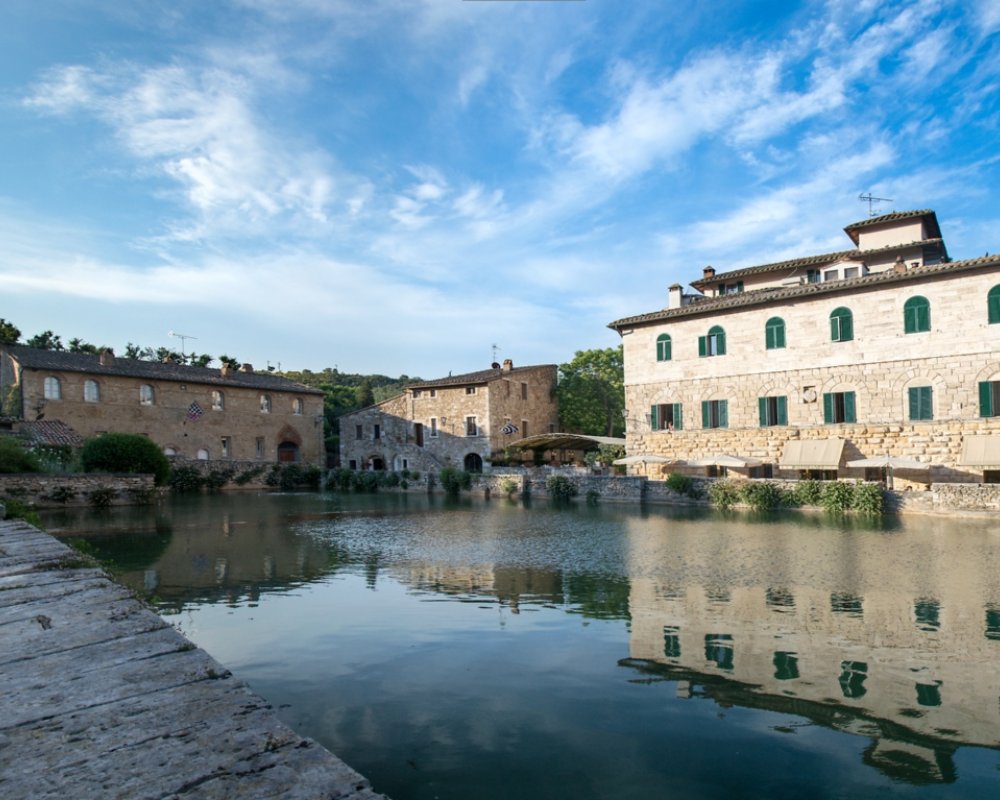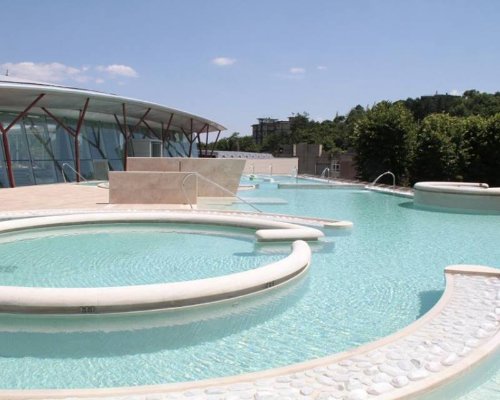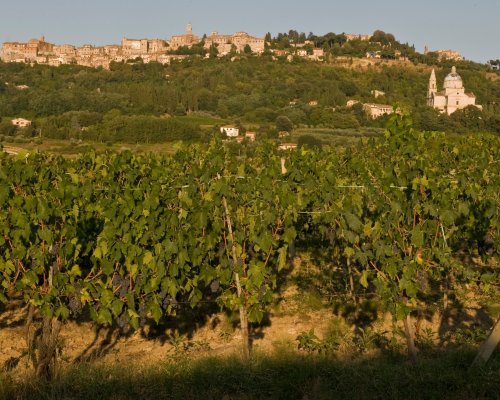A ride through Val d'Orcia and Val di Chiana: a haven of thermal baths
The route begins at Chianciano Terme, a renowned thermal spring location, known for the therapeutic properties of the waters, particularly for the treatment of liver conditions. A few years ago the thermal experience was enhanced with the addition of the Within the park is the Sensory Salon, an elegant spa where treatments are based on naturopathy. The historic centre of Chianciano Terme is also interesting to explore, where visitors can follow the Percorso Pirandelliano (Route of Pirandello) to discover the places where the famous writer lived and set many of his novels. The Museo Civico Archeologico “delle Acque” is also definitely not to be missed.
The route begins at Chianciano Terme, a renowned thermal spring location, known for the therapeutic properties of the waters, particularly for the treatment of liver conditions. A few years ago the thermal experience was enhanced with the addition of the Within the park is the Sensory Salon, an elegant spa where treatments are based on naturopathy. The historic centre of Chianciano Terme is also interesting to explore, where visitors can follow the Percorso Pirandelliano (Route of Pirandello) to discover the places where the famous writer lived and set many of his novels. The Museo Civico Archeologico “delle Acque” is also definitely not to be missed.
On leaving Chianciano Terme, from the historic centre, the route continues on the SP146 towards Montepulciano, only 10 Km away, famous throughout the world for the production of Vino Nobile wine. In the beautiful historic centre it is indeed possible to visit the old wineries and cellars, some of which are truly stunning, and to take part in some excellent wine tasting. A stroll along the main corso di Montepulciano is a must, to admire the splendid Renaissance palazzos and the main square Piazza Grande, Montepulciano’s grand parlour, not surprisingly used several times as a perfect set for films and commercials.
On leaving Chianciano Terme, from the historic centre, the route continues on the SP146 towards Montepulciano, only 10 Km away, famous throughout the world for the production of Vino Nobile wine. In the beautiful historic centre it is indeed possible to visit the old wineries and cellars, some of which are truly stunning, and to take part in some excellent wine tasting. A stroll along the main corso di Montepulciano is a must, to admire the splendid Renaissance palazzos and the main square Piazza Grande, Montepulciano’s grand parlour, not surprisingly used several times as a perfect set for films and commercials.
From Montepulciano the route continues on the SP146 towards Pienza, passing by one of the symbols of the Italian Renaissance, the beautiful Tempio di San Biagio, by the architect Sangallo. Pienza, one of four Unesco Sites in the province of Siena, lies only 14 Km to the west of Montepulciano and is considered la città ideale del Rinascimento (the perfect Renaissance city) with the geometry of its design in perfect harmony with the magnificence of the surrounding landscape. Pienza sits as an incredible terrace over the Val d’Orcia.
From Montepulciano the route continues on the SP146 towards Pienza, passing by one of the symbols of the Italian Renaissance, the beautiful Tempio di San Biagio, by the architect Sangallo. Pienza, one of four Unesco Sites in the province of Siena, lies only 14 Km to the west of Montepulciano and is considered la città ideale del Rinascimento (the perfect Renaissance city) with the geometry of its design in perfect harmony with the magnificence of the surrounding landscape. Pienza sits as an incredible terrace over the Val d’Orcia.
From Pienza the route leads on towards San Quirico d’Orcia, remaining on the SP146, passing by the Pieve di Corsignano church and the small chapel Cappella di Vitaleta which rise from the famous cornfields, as seen in the film Gladiator. The area of the Val d’Orcia, listed as a Unesco Site in 2004, is the first rural region to be recognized with such an important title. With its soft hills and tall cypresses, it is the example of the signature Italian landscape, so famous amongst the painters of the Siena School of Art. In 2003 the consortium Strada del Vino Orcia was also founded, unifying the wine produces of the region. San Quirico d’Orcia is another symbolic town of the valley, with its famous 13th-Century Collegiata church and the impressive 17th-Century Palazzo Chigi. Also worth a visit are the Horti Leonini, the 16th Century gardens created inside the city walls.
From Pienza the route leads on towards San Quirico d’Orcia, remaining on the SP146, passing by the Pieve di Corsignano church and the small chapel Cappella di Vitaleta which rise from the famous cornfields, as seen in the film Gladiator. The area of the Val d’Orcia, listed as a Unesco Site in 2004, is the first rural region to be recognized with such an important title. With its soft hills and tall cypresses, it is the example of the signature Italian landscape, so famous amongst the painters of the Siena School of Art. In 2003 the consortium Strada del Vino Orcia was also founded, unifying the wine produces of the region. San Quirico d’Orcia is another symbolic town of the valley, with its famous 13th-Century Collegiata church and the impressive 17th-Century Palazzo Chigi. Also worth a visit are the Horti Leonini, the 16th Century gardens created inside the city walls.
From San Quirico d’Orcia the route follows along the Cassia (SS2), the ancient via Francigena (pilgrimage route between Rome and Cantebury), and on to the medieval town of Bagno Vignoni, with the famous ancient Roman baths located right at its centre. The thermal springs at Bagno Vignoni have indeed been well known and well frequented since ancient times. Bagno Vignoni is only 15 Km from Pienza.
From San Quirico d’Orcia the route follows along the Cassia (SS2), the ancient via Francigena (pilgrimage route between Rome and Cantebury), and on to the medieval town of Bagno Vignoni, with the famous ancient Roman baths located right at its centre. The thermal springs at Bagno Vignoni have indeed been well known and well frequented since ancient times. Bagno Vignoni is only 15 Km from Pienza.
An alternative to this itinerary is to leave Chianciano Terme from Piazza Italia and take the Strada della Foce towards San Quirico d’Orcia. The curves of this road submerge you right into the Val d’Orcia and along the route you can admire the famous cypress lined country road, which has become the worldwide representative image of the Tuscan countryside. Other sights to note along the route are the Quercia delle Cecche, the oldest oak tree in the Val d’Orcia and the Castello di Spedaletto. Following on a part of the Cassia (SS2), Bagno Vignoni is only 25 Km to the west.
An alternative to this itinerary is to leave Chianciano Terme from Piazza Italia and take the Strada della Foce towards San Quirico d’Orcia. The curves of this road submerge you right into the Val d’Orcia and along the route you can admire the famous cypress lined country road, which has become the worldwide representative image of the Tuscan countryside. Other sights to note along the route are the Quercia delle Cecche, the oldest oak tree in the Val d’Orcia and the Castello di Spedaletto. Following on a part of the Cassia (SS2), Bagno Vignoni is only 25 Km to the west.


